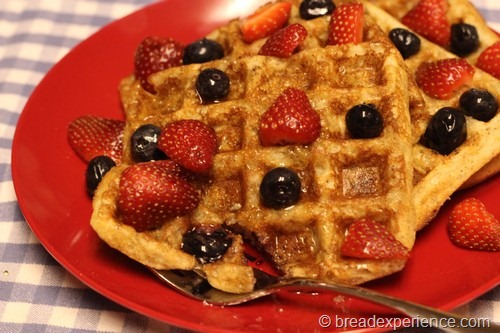Many different types of gluten-free flours can be used in gluten free breads. The delicious gluten-free waffles in the photo below are made with a mixture of brown and white rice flours, tapioca starch, potato starch, coconut flour and flaxseed meal.
 Gluten-Free Coconut and Flax Waffles
Gluten-Free Coconut and Flax Waffles
Types of Gluten-Free Flour
Some of the most common gluten-free flours used in gluten free bread recipes include: almond flour, brown and white rice flour, sweet rice flour, rice bran, rice starch, rice polish, tapioca flour, tapioca starch, potato flour, potato starch flour, soy flour, yellow and white cornmeal, polenta meal, cornstarch, corn bran, and acorn flour.
Gluten Free Bread Recipes
Here are some gluten free bread recipes for those who want an alternative to gluten breads. Most of the recipes are free of wheat, oats, barley, and rye. Some of the recipes are also lacto or milk-free.
| Recipe for wheat-free bread flour – To make wheat free bread, substitute one of these flours per cup of wheat bread flour. |
| Brown & White Bread – This rice flour bread recipe uses brown and white rice flour. Gluten-free flours are very fine and need to be well blended before liquid is added to them. |
| Cheese Bread – Recipe for gluten free cheese bread. The herbs and seeds provide a wonderful aroma and unique texture. |
| Fine Dinner Rolls – Recipe for gluten-free and milk free dinner rolls. |
| Flax-Coconut Waffles – Delicious and crispy gluten-free waffles made with brown rice flour, white rice flour, potato starch, tapioca starch, coconut flour and flaxseed meal. |
| Everyday Sandwich Bread – Recipe for an everyday Sandwich Bread that’s gluten-free as well as milk-free. |
| Pumpernickel Bread – Recipe for gluten-free pumpernickel bread. |
Click here to view a selection of gluten-free flours.
Other gluten-free ingredients used in breads
- Xantham powder is a substance used instead of gluten to bind the bread dough together in these types of breads.
- Other “gluten replacers” include guar gum and methylcellulose (methocel).
- Flour can also be made from legumes such as peas, mung beans, lentils, and garbanzo beans.
Tips for making gluten free breads
- Gluten free bread dough does not form a smooth ball like wheat flour dough. It more closely resembles whipped potatoes and doesn’t always mix up well in a bread machine unless you watch it and assist it with a rubber spatula occasionally.
- Beat eggs well before adding them to the rest of the ingredients.
- You can use RED STAR® Active Dry Yeast and RED STAR® QUICK•RISE™ Yeast because these yeasts do not contain wheat gluten or other cereal protein that cause allergic reactions in people with gluten intolerance.
- Yeast may be used cold. All other ingredients should be at room temperature (70ºF to 80ºF).
- Humidity, the type of flour, and the brand of flour influence the amount of liquid necessary for the proper consistency.
- Dough for gluten free breads is similar to that of quick breads, stiffer than cake batter, but not as stiff as cookie dough. If the dough appears too dry, add liquid, one tablespoon at a time; if the dough is too thin, add flour, one tablespoon at a time.
- To correct grainy or crumbly bread, add egg replacer (1 tablespoon) or increase xanthan gum (1/2 teaspoon). Unflavored gelatin (1 teaspoon) is another choice, however, a more moist bread results.
- One teaspoon cider vinegar in the bread recipes acts as a preservative.
- Omitting dry milk completely changes the texture and taste of the breads, but they are still delicious.
- To keep breads fresh and ready for use, slice cooled bread. Place slices together and wrap with aluminum foil, then place in a plastic bag and freeze. Slices will easily break apart and thaw rapidly.
Ingredient substitutions
- Fructose, molasses, and honey can replace sugar.
- Any vegetable oil or butter can replace canola oil.
- Rice flour can replace potato starch.
- Tofu can replace ricotta cheese.
- Lacto-free can replace dry milk; use equal proportions.
- Pulverized Nut-quik and dry baby formulas, such as Isomil, Prosobee, and Pregestimil, may be used in place of dry milk for soy and lactose intolerance. Use 1/3 cup to replace 1/2 cup dry milk.
- Egg Replacer can replace eggs. To substitute for 3 eggs, use 4 tablespoons dry egg replacer, mixing with the dry ingredients. Use a total of 2 cups water with the wet ingredients. Check dough consistency, adding more water if necessary.
- Potato starch, sometimes labeled potato starch flour, is very fine white flour that is excellent for baking when combined with other flours. Potato flour cannot be substituted for potato starch.
Additional resources for making gluten free breads:
- Check out the gluten-free flour section to find flours that can be used for baking bread.
- Browse the gluten-free baking mixes section for a selection of bread mixes.
- For more recipes and instructions, check out our selection of gluten free cookbooks.
Sources:
© Copyright 2008 Red Star Yeast. All Rights Reserved.
© 2008 gluten-free.com
Rehberg, Linda and Conway, Lois. The Bread Machine Magic Book of Helpful Hints. Second St. Martin’s Griffin Edition: November 1999.

Leave a Reply